|
|
|
Sort Order |
|
|
|
Items / Page
|
|
|
|
|
|
|
| Srl | Item |
| 1 |
ID:
188068
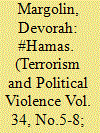

|
|
|
|
|
| Summary/Abstract |
As the debate on whether Hamas should be designated a terrorist organization intensifies across Europe and North America, policymakers and practitioners seek to identify the core principles that unify the group and its ideology. This paper contributes to this discussion by examining how Hamas uses Twitter to frame its narrative to English-speakers around the world. From March 2015 until November 2019, when its account was suspended from Twitter, Hamas operated an English-language Twitter handle under the name @HamasInfoEn. Using thematic content analysis to explore the first 2,848 tweets sent by Hamas in English—between March 2015 and March 2018—this paper explores the socio-political and religious narratives that lay at the core of Hamas’s online public diplomacy throughout its first three years on Twitter. Since its entrance into politics in 2006, some academics argue that Hamas has increasingly sought to distance itself from acts of terrorism and legitimize its actions as a governing actor, thereby seeking to carve out a place for itself in the international community. This study presents a nuanced understanding of how Hamas represents itself internationally, to better understand where the group is going, and how to best counter its narratives.
|
|
|
|
|
|
|
|
|
|
|
|
|
|
|
|
| 2 |
ID:
123229
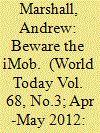

|
|
|
| 3 |
ID:
190943
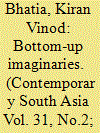

|
|
|
|
|
| Summary/Abstract |
In this article, I analyze discourses around the introduction of Intermediary Guidelines and Digital Media Code – new changes in laws regulating new media companies in India, and how these discourses inform the imaginations about the rights and duties of corporations and citizens in the country. I argue that though these guidelines were brought into effect through legal and juridical channels, they were reified through state-led and user-generated political discourse, constituting bottom-up imaginaries about the governance of social media platforms. To comprehensively analyze the impact of the guidelines regulating social media companies, this article argues for the need to examine the interlinkages between online discourse and policy regulations at three levels of operation: (a) the government’s imagination for the country’s digital future, (b) quotidian online discourse reifying the politics of regulation and (c) the dominant imagination of social media as socio-political actors responsible for upholding democracy, the freedom of speech of users, and dissent. Based on the findings and analysis, I argue that the regulation of social media platforms in India demonstrates reconfiguring relationships between social media companies, emerging forms of nationalism, and the government’s expectations of compliance from social media companies.
|
|
|
|
|
|
|
|
|
|
|
|
|
|
|
|
| 4 |
ID:
119751
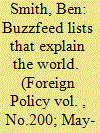

|
|
|
| 5 |
ID:
151585
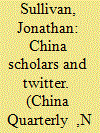

|
|
|
|
|
| Summary/Abstract |
Situating external engagement within the broader context of developments in Western higher education (HE) and technologies that are changing many aspects of academic life, this research note draws on the experiences of a large number of China scholars to assess the merits of Twitter for individual academics and the field as whole. Celebrating its tenth anniversary in March 2016, Twitter has shaken off its earlier image of celebrity stalking and inane ephemera and has become a tool used by many professionals working on China. Despite initial scepticism, many academics have recognized the utility of Twitter for various professional activities, including networking, increasing research visibility, gathering and disseminating information, and building a public profile. As external engagement activities become a routine expectation for academics in many Western universities, social media like Twitter have drawn attention as potentially useful tools. However, there are numerous obstacles to effective use, which this note addresses.
|
|
|
|
|
|
|
|
|
|
|
|
|
|
|
|
| 6 |
ID:
132273
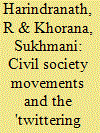

|
|
|
|
|
| Publication |
2014.
|
| Summary/Abstract |
Using Partha Chatterjee's insights on the formation of 'civil society' and how this is distinct from 'political society', this paper theorises the mobilisation of popular support via social media during the so-called 'anti-corruption movement' in India in 2011. It tracks the main themes of the civil society-led movement's Twitter feeds during two crucial phases of fasting by its self-proclaimed Gandhian leader, Anna Hazare. This highlights the mixing of nostalgic pre-independence discourses with new media savvy and provides a means of contextualising what such discursive mobilisation means for contemporary political formations in a post-colonial society such as India. The case study also sheds light on the urban- and middle-class-centred nature of the protest and its preference for media over electoral representation-this is in line with Chatterjee's conceptualisation of a civil society that undermines the authority of the state and excludes the rural and urban poor.
|
|
|
|
|
|
|
|
|
|
|
|
|
|
|
|
| 7 |
ID:
114365
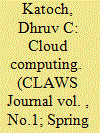

|
|
|
| 8 |
ID:
121609


|
|
|
|
|
| Publication |
2013.
|
| Summary/Abstract |
Recently, new electronic technologies have supplemented older mechanisms of communication between members of Congress and their constituents. These technologies have enhanced members' options for communication, both with constituents and other interested parties. This research examines member use of one specific electronic communication medium: Twitter. Using original data to examine patterns of use, two models predict the probability of a member adopting Twitter based on political, personal, and district-level variables.
|
|
|
|
|
|
|
|
|
|
|
|
|
|
|
|
| 9 |
ID:
171355


|
|
|
|
|
| Summary/Abstract |
Michael Jordan supposedly justified his decision to stay out of politics by noting that Republicans buy sneakers too. In the social media era, the name of the game for celebrities is engagement with fans. So why then do celebrities risk talking about politics on social media, which is likely to antagonize a portion of their fan base? With this question in mind, we analyze approximately 220,000 tweets from 83 celebrities who chose to endorse a presidential candidate in the 2016 U.S. presidential election campaign to assess whether there is a cost—defined in terms of engagement on Twitter—for celebrities who discuss presidential candidates. We also examine whether celebrities behave similarly to other campaign surrogates in being more likely to take on the “attack dog” role by going negative more often than going positive. More specifically, we document how often celebrities of distinct political preferences tweet about Donald Trump, Bernie Sanders, and Hillary Clinton, and we show that followers of opinionated celebrities do not withhold engagement when entertainers become politically mobilized and do indeed often go negative. Interestingly, in some cases political content from celebrities actually turns out to be more popular than typical lifestyle tweets.
|
|
|
|
|
|
|
|
|
|
|
|
|
|
|
|
| 10 |
ID:
155905
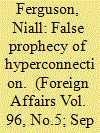

|
|
|
| 11 |
ID:
182573
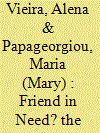

|
|
|
|
|
| Summary/Abstract |
The paper focuses on the COVID-19 as a stress test to the Sino-Russian strategic partnership: has it driven Russia and China closer together, farther apart, or made no difference? Employing content analysis of official Russian discourse as expressed by the Kremlin, the Government, and the Ministry of Foreign Affairs (MFA), both via their official web pages (104 online publications) and Twitter accounts (260 tweets), this study focuses on the Russian twiplomacy as a more suitable mean to reflect the real-time changes of an evolving crisis. The analysis demonstrates that the Sino-Russian relationship extends beyond the “axis of convenience.” It does not, however, correspond to the support expected from a consolidated (comprehensive) strategic partnership, nor does it achieve the intensity of soft balancing (vis-à-vis the USA) in a particularly polarized and politicized international context.
|
|
|
|
|
|
|
|
|
|
|
|
|
|
|
|
| 12 |
ID:
178395
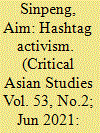

|
|
|
|
|
| Summary/Abstract |
The Thai 2020 anti-government protests were the first large-scale pro-democracy protests in Thailand mediated on Twitter. How has Twitter been used by anti-government supporters and to what effect? This article examines the use of hashtags by activists during the early stages of the Thai 2020 anti-government protests. Using an original dataset of 27,233 Twitter data points drawn from the #FreeYouth (FYM; #เยาวชนปลดแอก) campaign, the article argues that Twitter was used primarily to build collective narratives and disseminate movement information, rather than to mobilize offline protest activities. The key topic conversations within the Free Youth networks focus on discontent towards the government and demands for democracy, suggesting that Twitter was central to mobilizing pro-democracy collective action frames. The article further argues that the Free Youth networks on Twitter were loosely connected through community clusters of weak ties, not tight crowds. The challenge for FYM activists going forward is to support ties across its online networks that will strengthen over time, or risk becoming an ephemeral network of convenience that can only be mobilized on an ad hoc basis.
|
|
|
|
|
|
|
|
|
|
|
|
|
|
|
|
| 13 |
ID:
171232


|
|
|
|
|
| Summary/Abstract |
In May 2016, Britain’s signals intelligence agency the Government Communications Headquarters (GCHQ) joined the social media platform Twitter to considerable press fanfare. But to date, no analysis has been undertaken regarding the use and outcomes of social media by the agency - once referred to as Britain's 'most secret'. This article posits that, while the use of social media has allowed the agency to reach out to a new tech-savvy generation, its presence on the platform can sometimes stoke and amplify conspiracy theories affecting issues such as brand identity as GCHQ adopts a new, media friendly approach.
|
|
|
|
|
|
|
|
|
|
|
|
|
|
|
|
| 14 |
ID:
165256
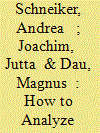

|
|
|
|
|
| Summary/Abstract |
Social scientists and international relations scholars are increasingly analyzing data collected from Twitter or Facebook to examine political processes in which social media are used. The sheer amount of web 2.0 data and its heterogeneity (including text, photos, and videos), however, pose challenges which analysts frequently seek to overcome through a mixed method approach relying on both quantitative and qualitative methods. This article discusses the advantages and limits of using mixed methods for analyzing social media. We show how the shortcomings of quantitative methods such as sentiment analysis and data mining can be remediated by qualitative content methods in a study of the Twitter activity of private military and security companies (PMSCs).
|
|
|
|
|
|
|
|
|
|
|
|
|
|
|
|
| 15 |
ID:
184042
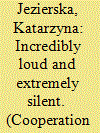

|
|
|
|
|
| Summary/Abstract |
In 2014, Sweden’s Feminist Foreign Policy (FFP) was announced with a fanfare. This article critically interrogates how Sweden implements the FFP through digital diplomacy by investigating the extent of Sweden’s gender equality activities on Twitter since the introduction of the FFP and by tracing gendered online abuse in digital diplomacy. I focus on Swedish embassy tweets towards two countries where feminism is highly contested – Poland and Hungary. The theoretical inspiration comes from discursive approaches to the spoken and unspoken, enriched by feminist observations about the non-binary character of voice/silence. The method applied is gender-driven quantitative and qualitative content analysis. The findings demonstrate that the FFP has not set any significant mark on digital diplomacy in the analyzed cases. The launching of the FFP went completely unnoticed and posts related to gender equality have actually decreased since 2014. There are no traces of ambassadors being subjected to gendered online abuse, but heavily xenophobic and paternalistic language is directed at Sweden as a representative of liberal policies. The article contributes to the literature on digital diplomacy by highlighting the (lack of) links between foreign policy and digital diplomacy and it addresses a gap by focusing on gender in digital diplomacy.
|
|
|
|
|
|
|
|
|
|
|
|
|
|
|
|
| 16 |
ID:
186842
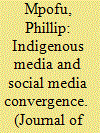

|
|
|
|
|
| Summary/Abstract |
Storytelling is ordinarily trivialised as an antiquated oramedia genre, and of less significance in Zimbabwean mainstream media and communication studies, hence it is understudied. Recent studies largely take a literary gaze on storytelling, and do not theorise it from an indigenous media viewpoint or appreciate its convergence with social media. Drawing on concepts of media convergence and the digital public sphere, this netnographic study examines the adaptation of storytelling on Twitter, SoundCloud and YouTube, focusing on patterns of production, delivery, participation, language forms, reception and audiences. The article shows inventive re-embodiment and adaptation of storytelling on online spaces, that is, the endurance and remaking of indigenous media in the context of new media and communication technologies. The manifestation of the folktale narrative style on social media exhibits the rise of a secondary form of orality recreated, reproduced and applied in the digital form and on social media. While digital and social media are perceived as threatening the continued existence of indigenous media, this article attests social media as breathing spaces for indigenous media.
|
|
|
|
|
|
|
|
|
|
|
|
|
|
|
|
| 17 |
ID:
115925


|
|
|
| 18 |
ID:
118641
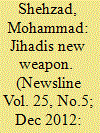

|
|
|
| 19 |
ID:
184061


|
|
|
|
|
| Summary/Abstract |
This paper establishes a new method of estimating public dissent that is both cost-effective and adaptable. Twitter allows users to post short messages that can be viewed and shared by other users, creating a network of freely and easily observable information. Drawing data directly from Twitter, we collect tweets containing specified words and phrases from citizens voicing dissatisfaction with their government. The collected tweets are processed using a regular expression based algorithm to estimate individual dissent; which is aggregated to an overall measure of public dissent. A comparative case study of Canada and Kenya during the summer of 2016 provides proof of concept. Controlling for user base differences, we find there is more public dissent in Kenya than Canada. This obvious, but necessary, result suggests that our measure of public dissent is a better representation of each country’s internal dynamics than other more sporadic measures. As a robustness check, we test our estimates against real-world civil unrest events. Results show our estimates of public dissent are significantly predictive of civil unrest events days before they occur in both countries.
|
|
|
|
|
|
|
|
|
|
|
|
|
|
|
|
| 20 |
ID:
171278


|
|
|
|
|
| Summary/Abstract |
This article examines the factors that influence whether members of Congress tweet about the #MeToo movement. Whereas social-identity theory suggests that congresswomen would be more likely to tweet about #MeToo, congressional research argues that increased polarization has resulted in congresswomen bucking gender stereotypes and embracing more partisan behavior than might otherwise be expected (Pearson and Dancey 2011). We examine how gender, partisanship, and ideology shape the Twitter activity of members of Congress surrounding the #MeToo movement using an original dataset of their tweets since October 2017 when the #MeToo movement gained prominence on Twitter. Our findings show that gender and ideology are the strongest predictors of whether Congress members tweet about the #MeToo movement. Liberals—particularly liberal women—are leading the charge in bringing prominence to the #MeToo movement on Twitter.
|
|
|
|
|
|
|
|
|
|
|
|
|
|
|
|
|
|
|
|
|